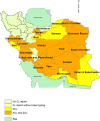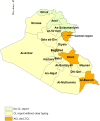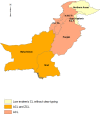The Geographical Distribution of Cutaneous Leishmaniasis Causative Agents in Iran and Its Neighboring Countries, A Review
- PMID: 32133334
- PMCID: PMC7039857
- DOI: 10.3389/fpubh.2020.00011
The Geographical Distribution of Cutaneous Leishmaniasis Causative Agents in Iran and Its Neighboring Countries, A Review
Abstract
Leishmania tropica and Leishmania major are both the main cause of anthroponotic (ACL) and zoonotic cutaneous leishmaniasis (ZCL), respectively, in the Old World. Leishmania infantum and Leishmania donovani, which are important causes of visceral leishmaniasis, have also occasionally been reported in CL patients. The present study investigates the current distribution of causative species of CL in Iran and neighboring countries in the Middle East. There has been expansion of L. tropica into new urban and rural foci in Iran, with well-documented cases of visceralization, a substantial increase of CL in Syria, and the emergence of new foci and outbreaks in Turkey and Iraq, especially due to L. major. Civil war in Syria and Iraq, population movement, poverty, and climatic change play important roles in the changing CL distribution in this region. Control programs should adopt a multidisciplinary approach based on active surveillance and case finding, especially in vulnerable refugee populations, determination of hazard maps for CL hot points using GIS and other advanced technology, the free distribution of drugs, rodent control, and greater community engagement in poor and marginalized populations. Comprehensive molecular studies that could show the species and strains of Leishmania in different areas of each country can give a better view from the distribution of CL in this region.
Keywords: Afghanistan; Iran; Iraq; Leishmania major; Leishmania tropica; Saudi Arabia; Syria; Turkey.
Copyright © 2020 Ghatee, Taylor and Karamian.
Figures







References
-
- Akhavan AA, Yaghoobi-Ershadi MR, Khamesipour A, Mirhendi H, Alimohammadian MH, Rassi Y, et al. . Dynamics of Leishmania infection rates in Rhombomys opimus (Rodentia: Gerbillinae) population of an endemic focus of zoonotic cutaneous leishmaniasis in Iran. Bull Soc Pathol Exot. (2010) 103:84–9. 10.1007/s13149-010-0044-1 - DOI - PubMed
Publication types
MeSH terms
LinkOut - more resources
Full Text Sources

